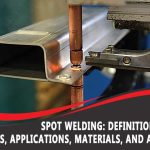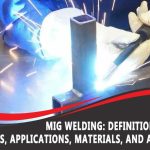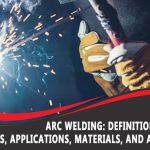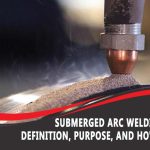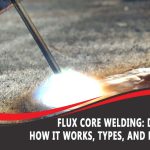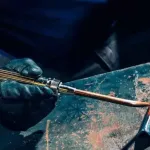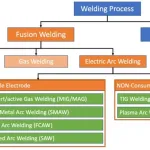This Electric Arc welding is the most commonly seen welding process in our lives. Yes! the welding you see in the welding shops to construct the metal gates, vehicle body repairs, and common engineering works. Those are all not the same Electric Arc Welding types. Let us discuss different types of Electric Arc Welding, their applications, and The striking technique that is used to weld with the Electric arc.
Electric Arc Welding
Electric Arc Welding is the Fusion type of welding. This Electric arc welding process preparation is similar to gas welding as we have discussed in the previous article.
Where the filler metal is supplied by a metal welding electrode The operator, with his eyes and face protected, strikes an arc by touching the work of base metal with the electrode. The base metal in the path of the arc stream is melted, forming a pool of molten metal, which seems to be forced out of the pool by the blast from the arc.
A small depression is formed in the base metal and the molten metal is deposited around the edge of this depression, which is called the arc crater. The slag is brushed off after the joint has cooled.
The arc welding does not require the metal to be preheated and since the temperature of the arc is quite high, therefore the fusion of the metal is almost instantaneous.
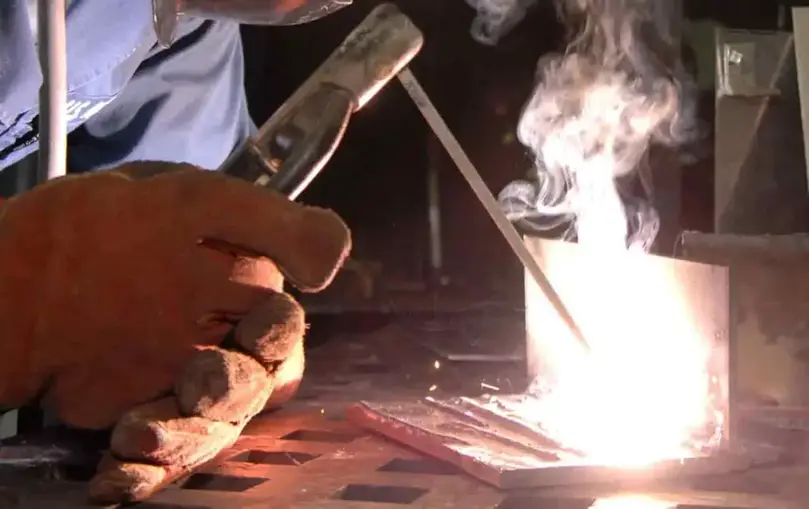
Electric Arc Welding Types Based on Electrode Consumption Method
The classification of Electric Arc welding is quite complex. Overall, there are at least 67 welding processes that welders used to join the metal. All of these are implemented from basic welding classifications. Such as Welding processes based on the type of electrode. And Based on the electrode consumption there are different Electric Arc Welding types available.
It is wise to classify the Electric Arc welding types under the Electrode consumption method.
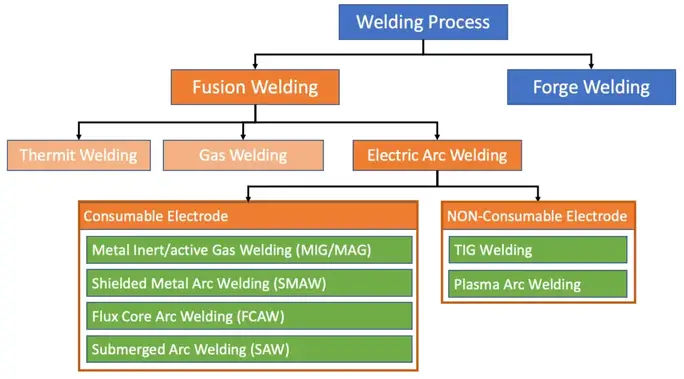
Consumed Electrode Method
- Metal Inert Gas Welding (MIG) or Metal Active Gas Welding (MAG) both known as Gas Metal Arc Welding (GMAW)
- Shielded Metal Arc Welding (SMAW) also known as Manual Metal Arc Welding (MMAW)
- Flux Core Arc Welding (FCAW)
- Submerged Arc Welding (SAW)
Non-Consumed Electrode Method
5. Gas Tungsten Arc Welding (GTAW) also known as Tungsten/inert gas Welding (TIG)
6. Plasma Arc Welding (PAW)
These are the main types of Electric Arc welding. let us discuss these in detail.
1. Gas Metal Arc Welding (GMAW)
Metal Inert Gas Welding (MIG) or Metal Active Gas Welding (MAG) both known as Gas Metal Arc Welding (GMAW). It is one of the most common types of welding. As the name suggests, the electrode is consumed during the welding process. In this Welding process, the arc is shielded by a gas like argon or helium or a gas mix. To prevent oxidation of the electrodes they have deoxidizers, making it possible to weld multiple layers.
Applications: MIG welding Used to weld thin sheets and sections. Examples are the auto industry for repairing vehicle exhausts and is also used in creating homes and buildings
Read the full article on MIG welding
2. Shielded Metal Arc Welding (SMAW)
Shielded Metal Arc Welding (SMAW) is also known as Manual Metal Arc Welding (MMAW). This Welding type is the oldest yet simplest process among the other types.
The arc is generated when the coated electrode tip touches the welding area and is then withdrawn to maintain the arc. The heat melts the tip, coating, and metal so that the weld is formed once that alloy solidifies.
Applications of Shielded metal Arc Weldings are preparing and construction of underwater pipelines and Shipbuilding works.
3. Flux Core Arc Welding (FCAW)
The name suggests that the electrode is in a tube and filled with flux. Flux is a purifying substance that is added to the molten metal, helps to bond with impurities.
While emissive flux shields the arc from the air, nonemissive fluxes may need shielding gases. Due to the higher metal deposition rate, this Flux core welding technique is used to weld dense sections that are an inch or thicker.
Applications of Flux Core Arc Welding are used for machining industries where dense metal parts needed to be welded.
4. Submerged Arc Welding (SAW)
Instead of flux substance, a granular flux is used in this Submerged Arc Welding. This granular flux helps to create a thick layer during welding, which completely covers the molten metal and prevents sparks and spatter.
Since the granular flux acts as a thermal insulator, This method enables deeper heat penetration. And there will be no smoke due to the flux covering the arc.
Applications of submerged arc Welding are high-speed sheet or plate steel welding and large products in the industry sector. There is one limitation thou. Only horizontal welding is possible with this method.
5. Tungsten/inert gas Welding (TIG)
Tungsten/inert gas Welding (TIG) is also known as Gas Tungsten Arc Welding (GTAW). In this type of welding technique, the electrode will not be consumed. So we must use separate filler material. an inert gas such as argon or helium or a mix of the two is used to protect the shield.
This Electrode is made up of Tungsten which is non-consumable. This TIG welding technique is often considered to be the most difficult since it required a skillful operator and is only performed at relatively low speeds. That is the reason, this welding process is used when more quality weldments are the requirement.
Applications of TIG welding are bicycles, aircraft, and marine applications.
Read the full article on TIG Welding
6. Plasma Arc Welding (PAW)
As similar to the above TIG welding technique, this plasma welding also uses the tungsten electrode but uses plasma gas to produce the arc.
This plasma produces narrow and more concentrated arcs. Due to the narrow Plasma jets, that produces more heat which enables this technique for speed increasing welding speeds.
Applications of Plasma Arc Welding are specially used for stainless steel pipe welding. Also, marine and aerospace industries use Plasma arc welding most of the time.
An alteration technic is that this plasma jet is used to cut steel parts efficiently. which is called Plasma Cutting.
Electric Arc Welding Types Based on Electrode
The second Classification of the Electric Arc welding process is based on the type of Electrode. There are two kinds of arc weldings depending upon the type of electrode.
a) Un-shielded arc welding
b) Shielded arc welding
a) Un-shielded arc welding
When a large electrode or filler rod is used for welding, it is then said to be un-shielded arc welding. In this case, the deposited weld metal while it is hot will absorb oxygen and nitrogen from the atmosphere. This decreases the strength of weld metal and lowers its ductility and resistance to corrosion.
b) Shielded Arc Welding
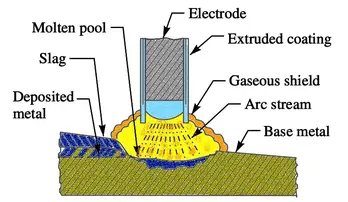
In shielded arc welding, the welding rods coated with solid material are used, as shown in the above schematic diagram. The resulting projection of coating focuses on a concentrated arc stream, which protects the globules of metal from the air and prevents the absorption of large amounts of harmful oxygen and nitrogen.
as we have discussed 7 different Arc Welding types if we categorize them all of them come under the shielded Arc Welding techniques.
How an Arc is produced in Arc Welding? | Striking an Arc
- To strike an arc, the electrode should be shorted by touching the work.
- At the moment of contact, a very heavy current starts flowing through the circuit, while voltage drops.
- Now, the electrode is lifted slowly so that a gap of 2–3 mm between the tip of the electrode and the workpiece is maintained.
- The voltage across the arc rises to about 15–20 volts and the amperage drops.
- Due to heat generated in the arc, the tip of the metal electrode starts melting and the gap increases.
- Unless the electrode is slowly moved towards the work at the same rate at which the tip of the electrode is melting maintaining the gap at 2–3 mm, the arc will extinguish.
- If the gap increases too much the machine voltage will not be able to maintain the arc.
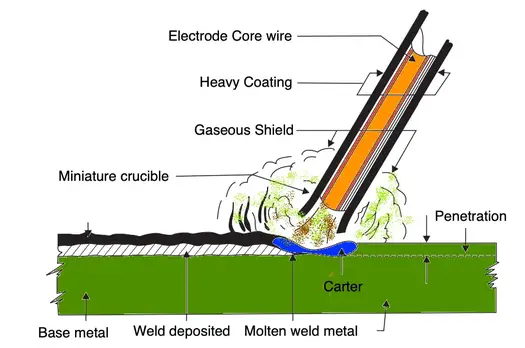
A great amount of heat (and intense light) is generated by the arc. It not only melts the electrode tip but also melts the workpiece at the location of the arc maintaining a pool of molten metal as shown in the above figure. In this way with help of the continuous arc, the welding process is done.
Conclusion
We have discussed the two different classifications of the Electric Arc Welding types and discussed the details of TIG, welding, MIG welding, PAW, welding, etc. Most importantly the main technique of striking an arc is also described. Let us know what do you think in the comment section below.


